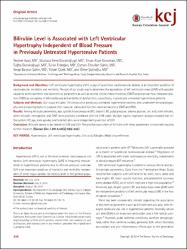Bilirubin level is associated with left ventricular hypertrophy independent of blood pressure in previously untreated hypertensive patients

View/
Access
info:eu-repo/semantics/openAccessDate
2014Author
Ayaz, TeslimeDurakoğlugil, Murtaza Emre
Kocaman, Sinan Altan
Durakoğlugil, Tuğba
Erdoğan, Turan
Şahin, Osman Zikrullah
Şahin, Serap Baydur
Çiçek, Yüksel
Şatıroğlu, Ömer
Metadata
Show full item recordCitation
Ayaz, T., Durakoglugil, M.E., Kocaman, S.A., Durakoglugil, T., Erdogan, T., Sahin, O.Z., Sahin, S.B. ve diğerleri, (2014).Bilirubin Level is Associated with Left Ventricular Hypertrophy Independent of Blood Pressure in Previously Untreated Hypertensive Patients.Korean Circulation Journal, 44(5), 336-343.https://doi.org/10.4070/kcj.2014.44.5.336Abstract
Background and Objectives: Left ventricular hypertrophy (LVH), a sign of subclinical cardiovascular disease, is an important predictor of cardiovascular morbidity and mortality. the aim of our study was to determine the association of left ventricular mass (LVM) with possible causative anthropometric and biochemical parameters as well as carotid intima-media thickness (CIMT) and brachial flow-mediated dilation (FMD) as surrogates of atherosclerosis and endothelial dysfunction, respectively, in previously untreated hypertensive patients. Subjects and Methods: Our study included 114 consecutive previously untreated hypertensive patients who underwent echocardiography and ultrasonography to evaluate their vascular status and function via brachial artery CIMT and FMD. Results: Among all study parameters, age, systolic blood pressure (BP), diastolic BP, pulse pressure, plasma glucose, uric acid, total bilirubin, direct bilirubin, hemoglobin, and CIMT were positively correlated with the LVM index. Multiple logistic regression analysis revealed that office systolic BP, age, male gender, and total bilirubin were independent predictors of LVH. Conclusion: Bilirubin seems to be related to LVM and LVH. the positive association of bilirubin with these parameters is novel and requires further research.

















